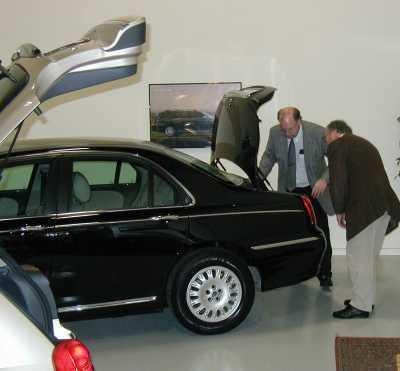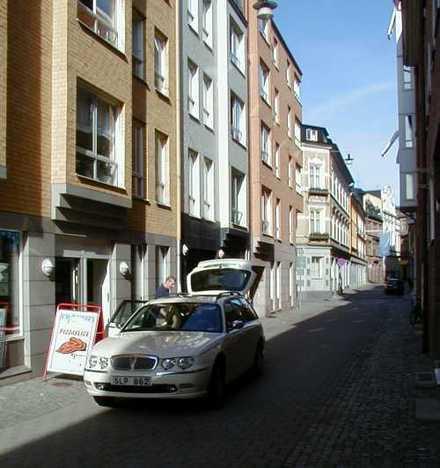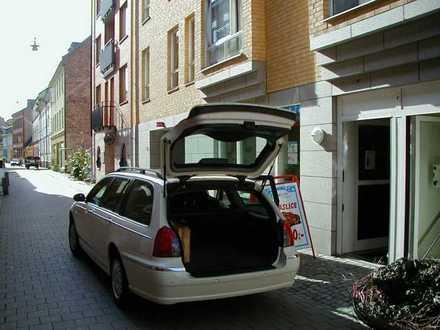Rover 75 Tourer

Håkan Andersen and Bo Arnholm from Rover Club of Sweden compares the luggage compartment between the Tourer and the Sedan.
Picture: Paul Adkin
Rover, or MG Rover as it is now called, has made little secret of its product plans for the near future. A series of sporting derivatives of the current Rover Cars line up, probably badged as MG versions, will be introduced during this year. So we can expect to see a new MG25, MG45 and MG75 during the middle of 2001. But the really interesting question is what will happen to the Rover cars products. Rover is keeping very quiet about this, with one exception - the Rover 75 estate.
New platform
Prior to the period of BMW ownership, the Rover 75 project was created to replace the ageing Rover 600 and 800 ranges with a single model. However, it quickly became clear that the car would need a new 'platform' to be competitive with the other cars in its sector in such areas as ride and handling, crash performance and suppression of road noise. This also created the possibility for other body styles to be considered for production on the same platform at significantly lower cost than developing separate cars. Overall styling was overseen by Rovers Richard Wooley; the man also responsible for the Rover 600 design.
Under the period of BMW ownership, the Rover 75 project (codenamed R40) was reviewed and revised to ensure BMW standards of quality could be achieved. BMW also offered technologies to Rover that were not previously available to them. One example was the R75 rear suspension design, where the BMW Z Axle was used instead of the Rover designed unit, as a means of achieving better ride and handling and lower costs to the group as a result of higher volumes purchased.
Developement stopped
Rover had also been working on other derivatives of the R75; a 2 door coupe, possibly to have been badged as a Riley and a 5 door estate, possibly to be badged 'Shooting Brake'. As work on the R75 saloon came to a close, the team was transferred to engineer the R75 estate for production. Then came the shock news of the sale of Rover; firstly to the Alchemy consortium and eventually to it's current owners, Phoenix, an ex Rover management group led by former executives John Towers and Nick Stephenson.
During this transition period from BMW ownership, all engineering work on new models was either stopped or dramatically reduced, as the management team put together it's plans for the new company. Very quickly though, it realised that the R75 estate was well on its way to production and needed relatively little work or expenditure to complete. So it was a relatively simple decision to continue the project and launch into production as soon as possible. During those first months, BMW's plans also became clearer and Rover decided to move production of the Rover 75 from Cowley near Oxford to the Longbridge factory in Birmingham, thus locating all of it's car production on one site. This was done by last September, only 3 months from the point of taking the decision; an amazingly quick time, considering the huge task involved in moving all the machinery, re setting it up and reorganising all the logistics for parts supply and completed vehicle delivery.
Very much like the saloon
Hence, the scene was set for the R75 estate to be introduced on the new facility at Longbridge during mid 2001. So what will it be like and how will it differ from the R75 saloon?
As you can see from the pictures, the estate version follows the saloons 'retro' styling theme, with virtually no changes to the front of the car, but a completely revised roof line and new 5th door. Overall styling is a matter of personal taste, but if you like the styling of the saloon, you will also like the styling of the estate as it is very handsome and well proportioned, rather than ungainly as some estates can be.
Same interior
The interior features the same dash and front seating as the saloon, but the main changes are at the rear. A 60/40 % spilt folding rear seat allows an extra 100kg of load carrying capacity, compared to the saloon and also the versatility to carry long items together with one or two passengers in the rear seats at the same time. The rear loadspace is protected from prying eyes by a roller blind cover, whilst an underfloor stowage compartment (similar to that used on the Land Rover Freelander) also allows items to be locked away in private. The vehicle is fully equipped with luggage hooks and lashing points to securely fasten down luggage and goods. Another novel feature is a fully electric rear luggage retention cassette system that will be offered as an option. Load capacity will vary from 400 litres with the rear seats up to 1446 litres with the seats folded.
On the outside, standard Roof Rails will allow extra load flexibility via the use of cross bars to accept the standard accessories such as roof boxes, ski holders etc.
A really novel feature is the clever 2 stage tailgate. The glass part of the tailgate can be opened on its own to give easy loading of luggage into the rear load area, without the need to open the whole tailgate. The tailgate itself extends deep into the rear bumper, allowing a very practical sized high opening.
Self levelling
As an optional extra, a self levelling rear suspension will be offered, which maintains the standard ride height whatever the load, to ensure consistently sharp and precise handling.
The standard range of engines will carry over from the saloon, so 1.8 litre K Series and 2.0 or 2.5 KV6 petrols will be available. The excellent BMW sourced 2.0 Common Rail diesel engine will also be an option. All models will be available with either manual or automatic transmissions.
Three trim levels
The basic 'Classic' trim
The mid range 'Club' trim
The top spec 'Connoisseur' trim.
These will be available in 5 interior colours, together with 12 exterior colours. Quite a selection! You can expect overall performance and fuel consumption to be very similar to the saloon, possibly 5% worse due to the increased weight of the estate body. Overall length will be 4792mm; 45mm longer than the saloon, whilst the width remains the same.
It's too early for Rover to announce prices, but industry sources suggest a premium of £1000 to £1500 over the price of the saloon. Whilst the loadspace volume and carrying capacity fall a little below that of the main full size competition (Opel Omega = 1800 litres, Volvo V70 = 1640 litres, Saab 9-5 = 1500 litres) the price, generous specification and style should ensure it is a popular choice.
Expected big-seller
Production figures for the estate are expected to reach 35% of the R75 total volume. Residual values on R75 saloon appear to be good so far, which is a reflection on the overall quality and rarity of the car, so it should also be a popular choice for business users who value the flexibility of an estate car which is also very stylish, comfortable and economical.
No news from Rover yet if the 75 estate will be available in Sweden, but it would certainly make an appealing alternative to the Volvo V40 / Audi A4 / BMW 3 Series Touring which dominate the market.



